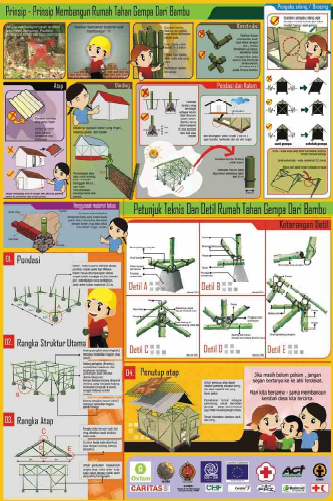DIY shelters save an ancient city
Six months ago an earthquake struck the ancient city of Yogyakarta, in Indoensia and killed 6,000 people, wounded 38,000 others, and according to estimates, have left over a million people homeless to live on sleeping mats, food, tarpaulins, and hygiene items distributed by the Indonesian Red Cross.
But, Relief Web reports, “As part of the International Federation’s early recovery programme, more than 4,000 bamboo shelters have already been completed in the areas of Gantiwarno and Dlingo, and the programme is expanding into other districts, where up to 6,000 of the homes are expected to soon be built.”
After consulting survivors and enabling them to take direct responsibility for the distribution of funds and reconstruction materials, the program has resulted in a coordinated community activism to help survivors build shelters themselves out of local materials.

[Image: This poster explains in Indonesian how the bamboo shelter can be constructed. You can learn more from this operations update (pdf) from September 19, 2006.]
Best part is towards the end of the article which tells how learning to build one's own bamboo shelter has also brought great skills to future work and entrepreneurialsm in the area. Survivors are now reviving their bamboo mat weaving trades, and see the shelter labor as providing valuable skills now the communities did not possess otherwise.
Nothing like seeing communities take charge of their destiny, even in the face of the most grim circumstances. In fact, that is where community is capable of functioning at its best.
But, Relief Web reports, “As part of the International Federation’s early recovery programme, more than 4,000 bamboo shelters have already been completed in the areas of Gantiwarno and Dlingo, and the programme is expanding into other districts, where up to 6,000 of the homes are expected to soon be built.”
After consulting survivors and enabling them to take direct responsibility for the distribution of funds and reconstruction materials, the program has resulted in a coordinated community activism to help survivors build shelters themselves out of local materials.

[Image: This poster explains in Indonesian how the bamboo shelter can be constructed. You can learn more from this operations update (pdf) from September 19, 2006.]
“Thousands of families living in tents and broken buildings have been shown a Red Cross video in recent weeks which teaches survivors how to build a traditional-style shelter, strong enough to withstand another earthquake.
The shelter is made entirely out of inexpensive local materials, such as bamboo and rope, and costs the equivalent of around 185 Swiss francs ($150 USD/ €118).
The secret of the quakeproof design lies in eliminating the use of nails. Instead, holes are drilled in the bamboo and wooden pins are hammered into the joints. They are then bound tightly with rope. It means the building is flexible but the bamboo will not split and break.”
Best part is towards the end of the article which tells how learning to build one's own bamboo shelter has also brought great skills to future work and entrepreneurialsm in the area. Survivors are now reviving their bamboo mat weaving trades, and see the shelter labor as providing valuable skills now the communities did not possess otherwise.
Nothing like seeing communities take charge of their destiny, even in the face of the most grim circumstances. In fact, that is where community is capable of functioning at its best.







4 Comments:
I am an architecture student at the University of Michigan. I am very interested in exploring alternative methods of building and construction, especially environmentally sustainable ones. Do you think you could be of assistance to me in obtaining one of these Indonesian disaster relief/construction tips posters?
sorry, i have no idea how you would obtain one, maybe contact architecture for humanity as they may have some contacts?
What a great project to distibute in what was such a time in need.
Some clues here :
http://www.grisb.org
I worked with them after the great sunami in Indonesia. See the "Rescue page" of www.CathaySeas.com
Sincerely yours,
- Yannick.
Post a Comment
<< Home